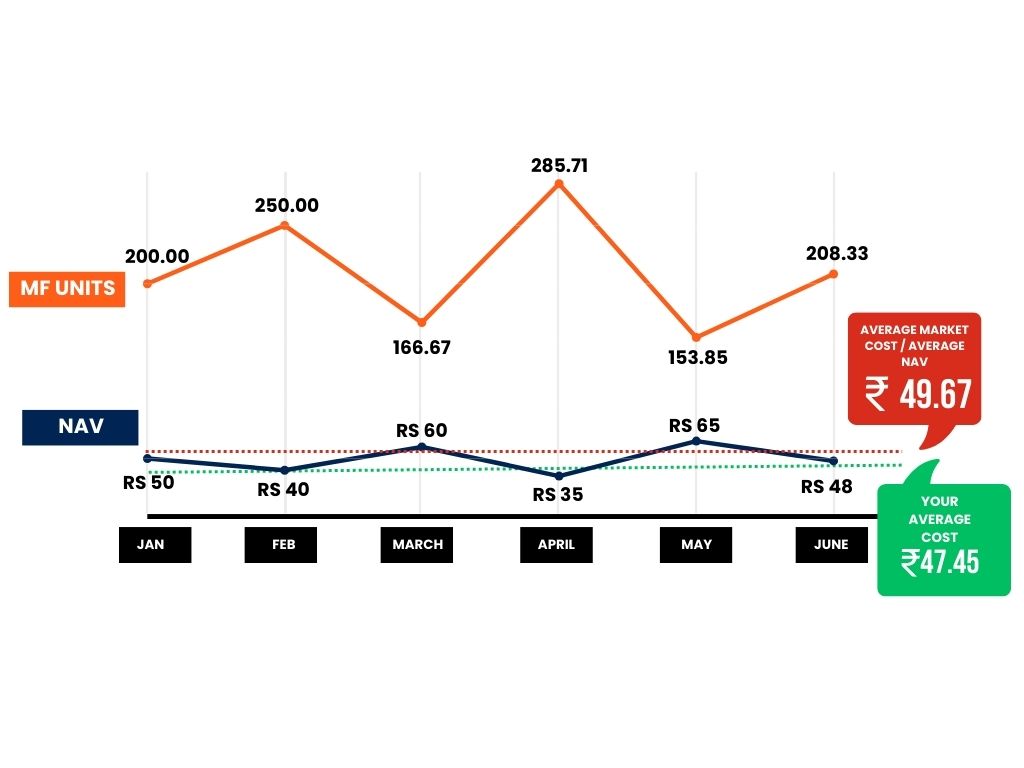“The key to getting forward is getting began. The key to getting began is breaking your advanced, overwhelming duties into small manageable duties, after which beginning on the primary one.”
Investing is usually seen as a fancy job, particularly when markets fluctuate. However with a Systematic Funding Plan (SIP), you may break this job into manageable items, permitting you to take a position frequently with out worrying about market timing. One of many biggest benefits of SIP is rupee value averaging, a easy but highly effective technique that helps you purchase mutual fund items at a mean value over time, no matter market situations. On this article, let’s discover how SIP and rupee value averaging can work collectively to construct wealth.
What’s Rupee Value Averaging?
Rupee Value Averaging works on the precept of shopping for extra items when the market is down and fewer items when the market is up. This helps in decreasing the general value of funding. For the reason that investor continues investing a hard and fast sum frequently, it removes the necessity to time the market.
Right here’s the way it works:
· Constant Funding: You make investments the identical quantity periodically.
· Unit Worth Fluctuation: The worth of the mutual fund items might rise or fall over time.
· Extra Models When Low, Fewer When Excessive: You purchase extra items when the worth is decrease and fewer items when the worth is greater.
· Common Value Discount: Over time, the typical value per unit tends to be decrease than the typical market worth, thanks to buying extra items at decrease costs.
Let’s think about a situation the place you make investments ₹10,000 each month by way of SIP in a mutual fund. The next desk exhibits the fluctuation of the Internet Asset Worth (NAV) of the mutual fund over 6 months.
| Month | SIP Quantity (₹) | NAV (₹) | Models Bought |
| January | ₹ 10,000 | ₹ 50 | 200.00 |
| February | ₹ 10,000 | ₹ 40 | 250.00 |
| March | ₹ 10,000 | ₹ 60 | 166.67 |
| April | ₹ 10,000 | ₹ 35 | 285.71 |
| Could | ₹ 10,000 | ₹ 65 | 153.85 |
| June | ₹ 10,000 | ₹ 48 | 208.33 |
| Whole | ₹ 60,000 | 1264.56 |
In January, to procure 200 items at ₹50 per unit.
In February, the market dropped, so the Internet Asset Worth (NAV) was ₹40. You purchased extra items—250 items for a similar ₹10,000.
In March, the NAV elevated to ₹60, so you may purchase solely 166.67 items.
This sample continues, shopping for extra items when the NAV is decrease and fewer when the NAV is greater.
Whole Funding Over 6 Months: ₹60,000
Whole Models Bought: 1264.56 items
Now, let’s calculate the typical value per unit and evaluate it with the typical NAV over this era:
Common Value per Unit = Whole Funding / Whole Models Bought
Common Value per Unit = ₹60,000 / 1264.56 = ₹47.45
Now let’s calculate the typical NAV throughout this era:
Common NAV = (₹50 + ₹40 + ₹60 + ₹35 + ₹65 + ₹48) / 6 = ₹49.67
By investing by way of SIP, the investor managed to decrease the typical value per unit to ₹47.45, despite the fact that the typical NAV throughout this risky interval out there (fluctuating from ₹35 to ₹65) was ₹49.67. That is the essence of Rupee Value Averaging.
Now, suppose you make investments all the ₹60,000 without delay in January when the NAV is ₹50.
Models Bought = ₹60,000 / ₹50 = 1200 items
Whole Worth at Finish of June (NAV of ₹48) = 1200 × ₹48 = ₹57,600
Whereas, whenever you make investments ₹10,000 each month for six months, as within the SIP instance above,
Whole Worth at Finish of June (NAV of ₹48) = 1264.56 × ₹48 = ₹60,698.90
| Funding Kind | Whole Funding (₹) | Models Bought | Whole Worth at June’s NAV (₹48) |
| Lumpsum | ₹ 60,000 | 1200 | ₹ 57,600 |
| SIP | ₹ 60,000 | 1264.56 | ₹ 60,698.90 |
With SIP, you bought 64.56 extra items than you’d have with an funding made solely at first. That is the good thing about rupee value averaging—by spreading your funding over time, you cut back the chance of market timing and decrease the typical value per unit.

Why Rupee Value Averaging is Helpful
Avoids Market Timing: SIPs eradicate the necessity to time the market. As a substitute of worrying about when to take a position, you robotically make investments at common intervals, which reduces the emotional stress of timing the proper market entry.
Smoothens Market Volatility: By investing frequently, you make the most of market fluctuations. When costs drop, you get extra items, and when costs rise, your funding grows. This smoothens the affect of market volatility.
Decrease Common Value: As seen within the instance, the typical value per unit by way of SIP was decrease than the typical market worth throughout the funding interval.
Compounding Advantages: SIPs, when maintained over lengthy intervals, profit from the facility of compounding. The returns in your investments are reinvested, additional accelerating wealth development.
Conclusion
SIP is a extremely efficient option to accumulate wealth over time with out worrying about market timing. By using Rupee Value Averaging, SIPs enable you decrease the typical value of your funding, leading to greater returns particularly throughout risky market situations.